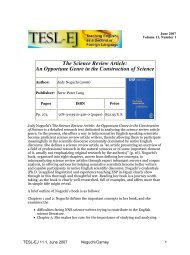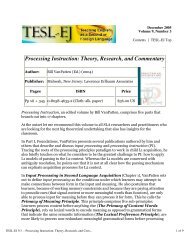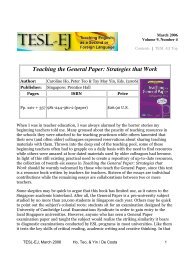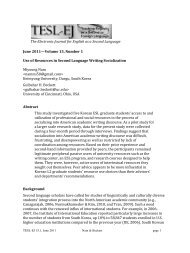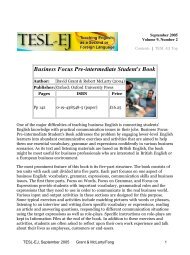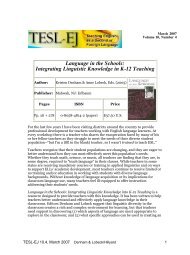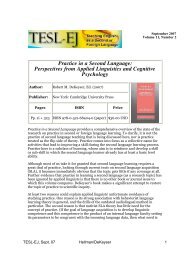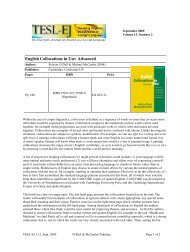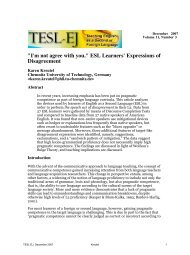TESL-EJ 10.3 -- Oxford Practice Grammar, Advanced
TESL-EJ 10.3 -- Oxford Practice Grammar, Advanced
TESL-EJ 10.3 -- Oxford Practice Grammar, Advanced
Create successful ePaper yourself
Turn your PDF publications into a flip-book with our unique Google optimized e-Paper software.
December 2006<br />
Volume 10, Number 3<br />
<strong>Oxford</strong> <strong>Practice</strong> <strong>Grammar</strong>, <strong>Advanced</strong><br />
Author: George Yule (2006)<br />
Publisher: <strong>Oxford</strong>: <strong>Oxford</strong> University Press<br />
Pages ISBN Price<br />
Pp. ix + 280 0-19-430916-9 (paper) £14.50 GBP<br />
Equipped with an easy-to-use answer key and a practice-plus CD-ROM, this<br />
grammar book is a great resource for students preparing for English examinations<br />
at the advanced level such as CAE (Cambridge Certificate in <strong>Advanced</strong> English), CPE<br />
(Cambridge Certificate of Proficiency in English), and the Michigan Test. Concise<br />
explanations of grammar points with examples on one page are followed by exercises<br />
conveniently accessed on the same and/or facing page. The exercises, chapter review<br />
tests, exit test, and additional tests on the CD-ROM are in formats such as<br />
multiple-choice, sentence-completion, and cloze. They offer plentiful practice in<br />
developing skills geared toward successful performance in tests targeting specific<br />
grammar points and idiomatic expressions. To that end, the book is best used as a<br />
reference guide for self-study or workbook to complement a grammar course.<br />
The book contains seventeen chapters covering common grammar topics:<br />
sentences<br />
verb tenses<br />
modals<br />
negatives and questions<br />
the passive<br />
articles and nouns<br />
determiners and quantifiers<br />
pronouns, substitution and ellipsis<br />
adjectives and adverbs<br />
prepositions<br />
infinitives and gerunds<br />
reporting<br />
noun clauses<br />
<strong>TESL</strong>-<strong>EJ</strong>, December 2006 Yule/Hu 1
elative clauses<br />
conditionals<br />
adverbial clauses<br />
connectors and focus structures.<br />
Each chapter begins with a brief introduction to the topic along with a passage<br />
containing the grammatical structure(s) identified and discussed in the chapter. Next,<br />
specific grammar points are explained in terms of form and/or use. In some<br />
chapters (e.g., Chapter 3 Modals), the discussion follows a notional approach by first<br />
presenting a notion and then identifying the grammar structures to express that<br />
notion (e.g., prediction: will, would, be going to, shall). In all cases, examples are<br />
provided for illustration. For each grammar topic, various exercises are provided in<br />
formats such as sentence completion, sentence rewrite, matching, cloze, and editing<br />
to help the learner better understand and use the structure(s) in question. Two types<br />
of exercises are especially worth mentioning. One integrates vocabulary learning in<br />
the exercises (an example is on p. 7) by requiring the learner to complete the<br />
definition of words and phrases using correct grammatical forms. The other, editing,<br />
requires the learner to find and correct grammatical errors in sentences or a<br />
paragraph. I used some of these editing exercises in my academic writing class and<br />
my students found them challenging and helpful.<br />
After the seventeen chapters and answer key to the exercises and unit tests is an exit<br />
test consisting of 34 short paragraphs. Each paragraph has four spaces to be filled in<br />
with multiple-choice answers. The fill-in-the-blanks at the paragraph level should help<br />
students learn to write extended texts.<br />
The book's chapter arrangement does not follow any specific order of difficulty.<br />
Therefore, users can choose to study the chapters in the order they like or study only<br />
the chapters or grammar points they need to.<br />
The CD-ROM contains interactive exercises and tests in three parts: Listen and<br />
Speak, Read and Write, and Test and Review. Listen and Speak has two parts. The<br />
first, Listening <strong>Practice</strong>, has five sets of exercises with ten audio single-sentence<br />
questions or statements in each set. Each question or statement is matched with<br />
three multiple-choice answers to test listening comprehension. An example is as<br />
follows:<br />
Listen to each question or statement and click on the best response:<br />
Listen "I'll remind Dr Brown that you're waiting."<br />
Dr Brown knows that you're waiting.<br />
Dr Brown doesn't know that you're waiting.<br />
I want to remind Dr Brown that you're waiting.<br />
The second part has twenty dialogues with blanks to be filled in to complete the<br />
sentences in the dialogues. Users can complete the sentences, check their answers on<br />
the screen, see correct answers, and audio-record their reading aloud of the dialogues<br />
and/or listen to pre-recorded readings. Here is an example:<br />
Dialogue 13: Prepositions<br />
<strong>TESL</strong>-<strong>EJ</strong>, December 2006 Yule/Hu 2
Read the dialogue and then write in the parts that are missing.<br />
Sometimes different answers are possible. When you have finished, you<br />
can record yourself taking part in the conversation. (Then you can listen<br />
to yourself or the model dialogue.)<br />
Information: You and a friend are chatting.<br />
Friend Did you say you were going away soon?<br />
You Yes, I'm going to Skye ______ Friday.<br />
Friend Where's that?<br />
You It's a small island ______ the west coast of Scotland.<br />
Friend Where will you stay?<br />
You I'm staying ______ some friends who've rented a house there.<br />
Friend Are you going for long?<br />
You No, I'm only going ______ a few days.<br />
Friend Why?<br />
You I've got an interview ______ the following Thursday.<br />
Completing these dialogues is useful practice in preparing for listening<br />
comprehension tests similar to some found in the paper- or computer-based TOEFL.<br />
Read and Write contains 34 paragraph-editing exercises, pairs of which correspond<br />
to each of the seventeen chapters of the book. One paragraph of each pair is shorter,<br />
with five mistakes; the other longer, with ten mistakes. Users need to find and try to<br />
correct each grammatical error before moving to the next. A right correction is<br />
confirmed instantly; otherwise, the right answer is provided. This section is claimed<br />
to be "the only grammar CD-ROM [available] with interactive 'find and correct the<br />
mistake' exercises" (back cover). Such editing exercises should help users improve<br />
grammatical accuracy in their writing.<br />
Test and Review consists of four tests, each with 50 multiple-choice<br />
sentence-completion items on grammar points discussed in the chapters. The review<br />
part indicates the page number in the book where the grammar point tested is<br />
explained. Thus, users can refer to the book for explanations of why their answer is<br />
right or wrong.<br />
What is noticeably missing in Yule's book are pair or group exercises to develop<br />
communicative skills. Such interactive tasks have been the focus of much grammar<br />
practice in North American classrooms for the past twenty-plus years. In this sense,<br />
the book is not ideal for teachers searching for a text to help students develop<br />
grammar skills for communication, spoken or written. To develop communicative<br />
skills, Azar (1999) might be a better choice.<br />
Additionally, considering such a lack of communicative grammar practice, it is highly<br />
questionable that the book can best prepare students for success in<br />
communication-oriented tests such as the current iBT TOEFL (the Internet based<br />
next generation TOEFL), which tests integrated language skills, rather than discrete<br />
grammar points, using extended authentic discourse from North American<br />
<strong>TESL</strong>-<strong>EJ</strong>, December 2006 Yule/Hu 3
post-secondary classrooms, lecture halls, and campus life. In fact, the iBT TOEFL no<br />
longer has the grammatical structure section that appears in the paper- and<br />
computer-based TOEFL currently being phased out, but instead embeds the testing of<br />
grammar skills in all the sections. Thus, it is misleading to claim that the book "helps<br />
you prepare for standard exam questions asked in TOEFL" (back cover; see also pp.<br />
viii-ix).<br />
Except for the illustrations to support some of the passages at the beginning of each<br />
chapter (e.g., pp. 28 and 68), Yule makes scarce use of graphs or graphics. Pictures<br />
illustrating some of the exercises (e.g., p. 131) are helpful but very limited. Such a<br />
shortage not only tends to make the explanations and exercises lifeless, monotonous,<br />
and boring, but may present difficulties for readers who are not abstract thinkers or<br />
whose reading comprehension is not highly proficient--”though to be fair, the book is<br />
designated as an advanced grammar. A chart summary of the modals, for example,<br />
would be very helpful for readers to compare and contrast the modals. This problem<br />
is even more serious with the CD-ROM since there is not a single graphic in the tests.<br />
Furthermore, in the CD-ROM Listen and Speak section Dialogue 13 has these<br />
instructions: Read the dialogue and then write in the parts that are missing.<br />
Sometimes different answers are possible.<br />
Friend Did you say you were going away soon?<br />
You<br />
Yes, I'm going to Skye ___ Friday.<br />
The program accepts "next" as correct but rejects "this" as wrong. The program<br />
should allow multiple correct answers; otherwise, it gives the misleading impression<br />
that "this" is wrong. (In fact, since the dialogue is labeled Prepositions, wouldn't "on"<br />
be a student's first choice?) In any case, just stating "different answers are possible"<br />
is inadequate for some learners who are not sure or aware that an answer rejected as<br />
wrong is not so. Surely a computer programmer could have rectified this easily<br />
enough.Lastly, the answer key at the back of the book makes it convenient for<br />
students to check their answers to the chapter exercises and tests. The key is helpful<br />
especially for self-study. But the same convenience can be misused by students who<br />
may want to copy the key's answers to the exercises in order to appear correct when<br />
going over the exercises in class. In this case the key helps those students cover up<br />
their lack of understanding or misunderstanding of the grammar points. Providing<br />
the answer key in a separate booklet could give the teacher control over its access if<br />
the book is used as a class textbook or workbook.<br />
Reference<br />
Azar, B. (1999). Understanding and using English grammar (3rd ed.). London:<br />
Longman.<br />
Jim Hu<br />
Thompson Rivers University, Canada<br />
<br />
© Copyright rests with authors. Please cite <strong>TESL</strong>-<strong>EJ</strong> appropriately.<br />
<strong>TESL</strong>-<strong>EJ</strong>, December 2006 Yule/Hu 4



